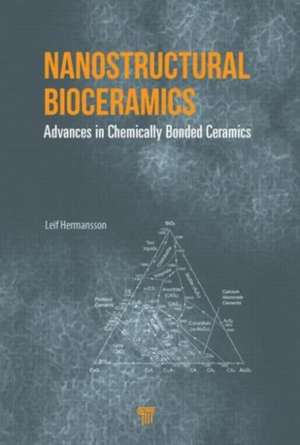Nanostructural Bioceramics: Advances in Chemically Bonded Ceramics
Editat de Leif Hermanssonen Limba Engleză Hardback – 20 aug 2014
Preț: 615.08 lei
Preț vechi: 747.73 lei
-18% Nou
Puncte Express: 923
Preț estimativ în valută:
117.73€ • 127.93$ • 98.96£
117.73€ • 127.93$ • 98.96£
Comandă specială
Livrare economică 31 martie-14 aprilie
Doresc să fiu notificat când acest titlu va fi disponibil:
Se trimite...
Preluare comenzi: 021 569.72.76
Specificații
ISBN-13: 9789814463430
ISBN-10: 9814463434
Pagini: 170
Ilustrații: 39 black & white illustrations, 5 colour illustrations
Dimensiuni: 152 x 229 x 15 mm
Greutate: 0.38 kg
Ediția:1
Editura: Jenny Stanford Publishing
Colecția Jenny Stanford Publishing
ISBN-10: 9814463434
Pagini: 170
Ilustrații: 39 black & white illustrations, 5 colour illustrations
Dimensiuni: 152 x 229 x 15 mm
Greutate: 0.38 kg
Ediția:1
Editura: Jenny Stanford Publishing
Colecția Jenny Stanford Publishing
Public țintă
Academic and PostgraduateCuprins
Introduction to Nanostructural Chemically Bonded Bioceramics. Classification of Bioceramics. General Properties. Specific Properties. Nanostructural Mechanisms and Integration to Hard Tissue. Nanostructures Including Nanoporosity. Applications. Future Trends.
Recenzii
"This book describes a new family of in situ in vivo produced bioceramics with high potential within dentistry and orthopedics. The importance of nanostructural properties is thrilling, and thoroughly described."
—Prof. Roger Narayan, North Carolina State University, USA
"This book is an excellent introduction to the field of bionanomaterials for the researcher as well as the newcomer to the field. It introduces readers to the structure and characteristics of new bioceramics, chemically bonded nanobioceramics, and their interaction with tissues in vivo and in vitro, posing the question: What determines the biocompatibility and the toxicity of such new inserts in human bodies? The book thoroughly explains chemically bonded bioceramics from a chemical composition and mineralogy point of view and early tissue response, providing researchers with comprehensive knowledge about nanobioceramics for practical applications."
—Walid M. Daoush, Helwan University, Egypt
—Prof. Roger Narayan, North Carolina State University, USA
"This book is an excellent introduction to the field of bionanomaterials for the researcher as well as the newcomer to the field. It introduces readers to the structure and characteristics of new bioceramics, chemically bonded nanobioceramics, and their interaction with tissues in vivo and in vitro, posing the question: What determines the biocompatibility and the toxicity of such new inserts in human bodies? The book thoroughly explains chemically bonded bioceramics from a chemical composition and mineralogy point of view and early tissue response, providing researchers with comprehensive knowledge about nanobioceramics for practical applications."
—Walid M. Daoush, Helwan University, Egypt
Notă biografică
Leif Hermansson is founder of Doxa AB, Sweden, and holds two professorships, one in materials chemistry within bioceramics and the other in structural ceramics. He has held various positions at Uppsala University and Stockholm University and lectures regularly at conferences on biomaterials all over the world. He has published 75 scientific papers and is author of 40 original patents in biomaterials, including ceramic processing, properties, and applications.
Descriere
Biomaterials are produced in situ and in vivo in the body using mainly hydration reactions, that is, reactions between phosphates, silicates or aluminates, and water. The nanostructural integration of these biomaterials in the body is controlled by six mechanisms. The biomaterial interaction with body liquid results in bioactivity and total closure of the contact zone between the biomaterial and hard tissue.
This book describes the new biomaterials based on nanostructural chemically bonded bioceramics and discusses their general and specific properties. It presents an overview of the nanostructural chemically bonded bioceramics, including their processing aspects, properties, integration with tissues, relation to other bioceramics and biomaterials, and nanostructural integration in different dental and orthopaedic applications. The book also describes the potential application areas for these new chemically bonded bioceramics.
This book describes the new biomaterials based on nanostructural chemically bonded bioceramics and discusses their general and specific properties. It presents an overview of the nanostructural chemically bonded bioceramics, including their processing aspects, properties, integration with tissues, relation to other bioceramics and biomaterials, and nanostructural integration in different dental and orthopaedic applications. The book also describes the potential application areas for these new chemically bonded bioceramics.
